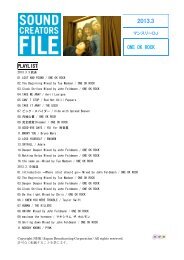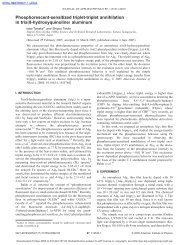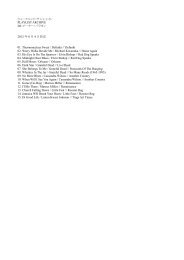Children's Television: Trends Around the World
Children's Television: Trends Around the World
Children's Television: Trends Around the World
Create successful ePaper yourself
Turn your PDF publications into a flip-book with our unique Google optimized e-Paper software.
CHILDREN’S TELEVISION: TRENDS AROUND THE WORLD<br />
111<br />
Figure 2. Hours per Day of Children’s <strong>Television</strong> in Japan (terrestrial channels only)<br />
hours/day<br />
16<br />
14<br />
12<br />
10<br />
8<br />
6<br />
4<br />
2<br />
0<br />
’53<br />
NHK General<br />
Commercial<br />
NHK Educational<br />
’58 ’63 ’68 ’73 ’78 ’83 ’88 ’93 ’98 ’03<br />
year<br />
Source: NHK Broadcasting Culture Research Institute (ed.). Terebi shicho no gojunen:<br />
Terebi wa nani o tsutae, do mirarete kita no ka [Fifty Years of <strong>Television</strong> Viewing in<br />
Japan: What <strong>Television</strong> Has Conveyed, and How It Has Been Viewed]. Nippon Hoso<br />
Shuppan Kyokai. 2003. p. 95.<br />
Notes:<br />
1. The term “children’s television” refers here to all programs, on <strong>the</strong> channels investigated,<br />
for children up to junior high school age (around age 14), including cartoons and programs<br />
for preschoolers. Schools programming is excluded.<br />
2. The number of hours of children’s television per day was taken as 1/7th of <strong>the</strong> weekly<br />
total, calculated on <strong>the</strong> basis of each channel’s television schedule for April of each year.<br />
As of April 1953, NHK General was <strong>the</strong> only channel. As of 1963, <strong>the</strong>re were only four<br />
commercial channels, Tokyo Channel 12 (now, TV Tokyo) not being launched until<br />
Educational, and today, that is where almost all public television children’s<br />
programs are shown.<br />
In 2003, <strong>the</strong> fiftieth anniversary of television in Japan, NHK broadcast an<br />
average of six hours of children’s programs per day (excluding school programs)—an<br />
amount that just topped <strong>the</strong> total children’s broadcasting volume<br />
on <strong>the</strong> five commercial channels in <strong>the</strong> Tokyo area. 9<br />
9 NHK Broadcasting Culture Research Institute (ed.), Terebi shicho no gojunen: Terebi wa<br />
nani o tsutae, do mirarete kita no ka [Fifty Years of <strong>Television</strong> Viewing in Japan: What<br />
<strong>Television</strong> Has Conveyed, and How It Has Been Viewed]. Nippon Hoso Shuppan Kyokai.<br />
2003. See, in particular, <strong>the</strong> graph on p. 95, and also pp. 25–27, 41–45, 60–63, 93–99.







